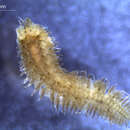en
names in breadcrumbs


Gattyana cirrhosa is a scale worm known from widespread locations in the North Atlantic, Arctic, and northwestern Pacific oceans, from the intertidal zone to depths of at least 1,200 m (3,900 ft).[2][3]
Gattyana cirrhosa is a short-bodied worm with 38 segments and 15 pairs of elytra, which bear a marginal fringe of papillae and are a rich brassy-orange colour. The lateral antennae are positioned ventrally on the prostomium, directly beneath the median antenna. Notochaetae are about as thick as or thinner than the neurochaetae.[2][4]
Gattyana cirrhosa has a commensal relationship with chaetopterid, terebellid, and pectinariid polychaete worms, living within the tubes they construct. However, it is also a free-living taxon.
Gattyana cirrhosa is a scale worm known from widespread locations in the North Atlantic, Arctic, and northwestern Pacific oceans, from the intertidal zone to depths of at least 1,200 m (3,900 ft).